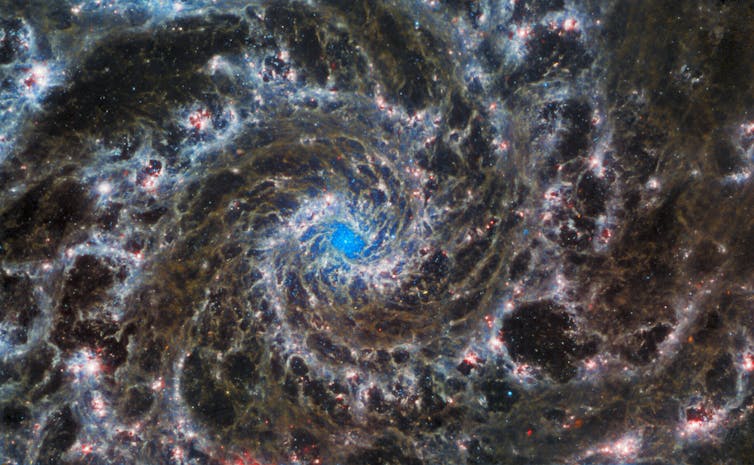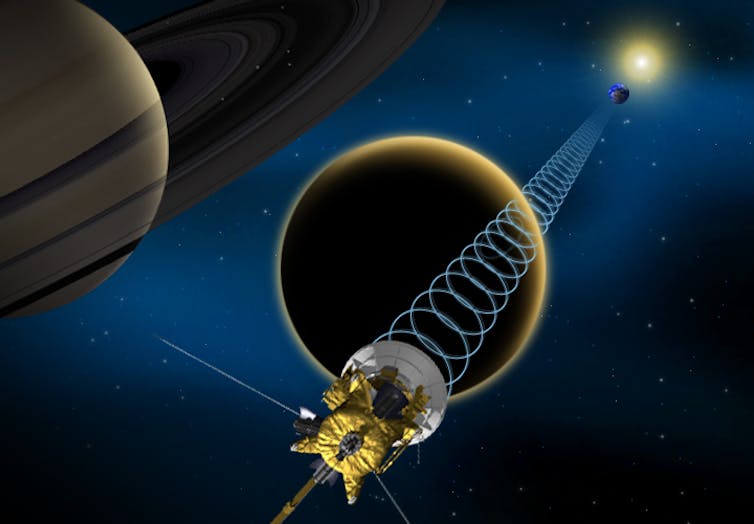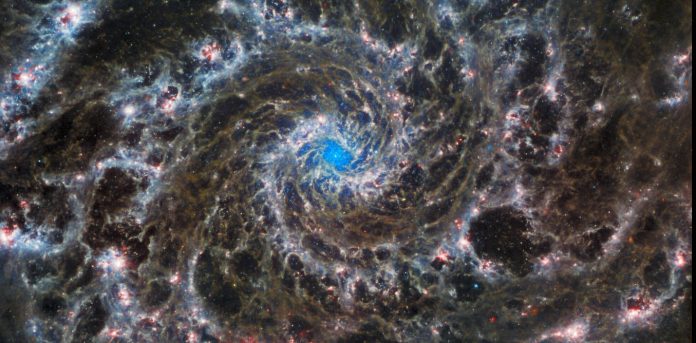Is dark matter’s main rival theory dead? There’s bad news from the Cassini spacecraft and other recent tests

Indranil Banik, University of St Andrews and Harry Desmond, University of Portsmouth
One of the biggest mysteries in astrophysics today is that the forces in galaxies do not seem to add up. Galaxies rotate much faster than predicted by applying Newton’s law of gravity to their visible matter, despite those laws working well everywhere in the Solar System.
To prevent galaxies from flying apart, some additional gravity is needed. This is why the idea of an invisible substance called dark matter was first proposed. But nobody has ever seen the stuff. And there are no particles in the hugely successful Standard Model of particle physics that could be the dark matter – it must be something quite exotic.
This has led to the rival idea that the galactic discrepancies are caused instead by a breakdown of Newton’s laws. The most successful such idea is known as Milgromian dynamics or Mond, proposed by Israeli physicist Mordehai Milgrom in 1982. But our recent research shows this theory is in trouble.
The main postulate of Mond is that gravity starts behaving differently to what Newton expected when it becomes very weak, as at the edges of galaxies. Mond is quite successful at predicting galaxy rotation without any dark matter, and it has a few other successes. But many of these can also be explained with dark matter, preserving Newton’s laws.
So how do we put Mond to a definitive test? We have been pursuing this for many years. The key is that Mond only changes the behaviour of gravity at low accelerations, not at a specific distance from an object. You’ll feel lower acceleration on the outskirts of any celestial object – a planet, star or galaxy – than when you are close to it. But it is the amount of acceleration, rather than the distance, that predicts where gravity should be stronger.
This means that, although Mond effects would typically kick in several thousand light years away from a galaxy, if we look at an individual star, the effects would become highly significant at a tenth of a light year. That is only a few thousand times larger than an astronomical unit (AU) – the distance between the Earth and the Sun. But weaker Mond effects should also be detectable at even smaller scales, such as in the outer Solar System.
This brings us to the Cassini mission, which orbited Saturn between 2004 and its final fiery crash into the planet in 2017. Saturn orbits the Sun at 10 AU. Due to a quirk of Mond, the gravity from the rest of our galaxy should cause Saturn’s orbit to deviate from the Newtonian expectation in a subtle way.

This can be tested by timing radio pulses between Earth and Cassini. Since Cassini was orbiting Saturn, this helped to measure the Earth-Saturn distance and allowed us to precisely track Saturn’s orbit. But Cassini did not find any anomaly of the kind expected in Mond. Newton still works well for Saturn.
One of us, Harry Desmond, recently published a study investigating the results in greater depth. Perhaps Mond would fit the Cassini data if we tweaked how we calculate galaxy masses from their brightness? That would affect how much of a boost to gravity Mond has to provide to fit models of galaxy rotation, and thus what we should expect for Saturn’s orbit.
Another uncertainty is the gravity from surrounding galaxies, which has a minor effect. But the study showed that, given how Mond would have to work to fit with models for galaxy rotation, it cannot also fit the Cassini radio tracking results – no matter how we tweak the calculations.
With the standard assumptions considered most likely by astronomers and allowing for a wide range of uncertainties, the chance of Mond matching the Cassini results is the same as a flipped coin landing heads up 59 times in a row. This is more than twice the “5 sigma” gold standard for a discovery in science, which corresponds to about 21 coin flips in a row.
More bad news for Mond
That’s not the only bad news for Mond. Another test is provided by wide binary stars – two stars that orbit a shared centre several thousand AU apart. Mond predicted that such stars should orbit around each other 20% faster than expected with Newton’s laws. But one of us, Indranil Banik, recently led a very detailed study that rules out this prediction. The chance of Mond being right given these results is the same as a fair coin landing heads up 190 times in a row.
Results from yet another team show that Mond also fails to explain small bodies in the distant outer Solar System. Comets coming in from out there have a much narrower distribution in energy than Mond predicts. These bodies also have orbits that are usually only slightly inclined to the plane that all the planets orbit close to. Mond would cause the inclinations to be much larger.
Newtonian gravity is strongly preferred over Mond on length scales below about a light year. But Mond also fails on scales larger than galaxies: it cannot explain the motions within galaxy clusters. Dark matter was first proposed by Fritz Zwicky in the 1930s to account for the random motions of galaxies within the Coma Cluster, which requires more gravity to hold it together than the visible mass can provide.
Mond cannot provide enough gravity either, at least in the central regions of galaxy clusters. But in their outskirts, Mond provides too much gravity. Assuming instead Newtonian gravity, with five times as much dark matter as normal matter, seems to provide a good fit to the data.
The standard dark matter model of cosmology isn’t perfect, however. There are things it struggles to explain, from the universe’s expansion rate to giant cosmic structures. So we may not yet have the perfect model. It seems dark matter is here to stay, but its nature may be different to what the Standard Model suggests. Or gravity may indeed be stronger than we think – but on very large scales only.
Ultimately though, Mond, as presently formulated, cannot be considered a viable alternative to dark matter any more. We may not like it, but the dark side still holds sway.![]()
Indranil Banik, Postdoctoral Research Fellow in Astrophysics, University of St Andrews and Harry Desmond, Senior Research Fellow of Cosmology, University of Portsmouth
This article is republished from The Conversation under a Creative Commons license. Read the original article.



